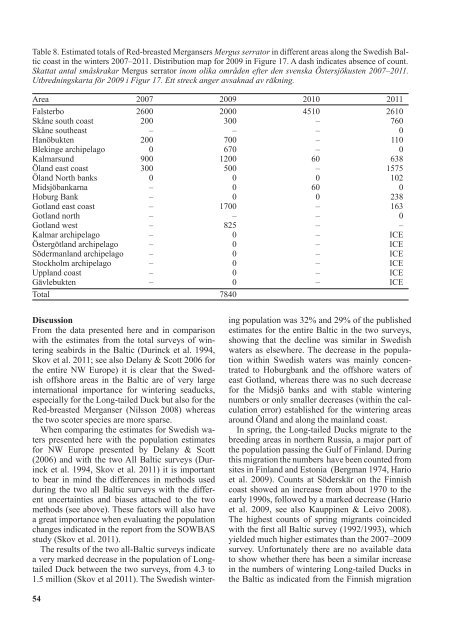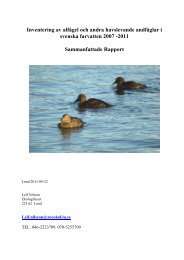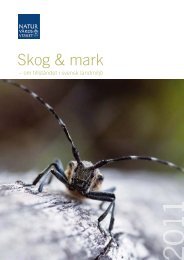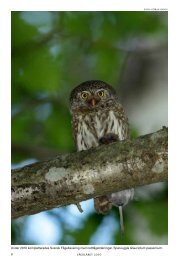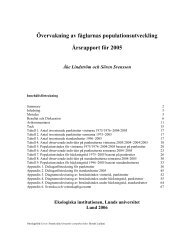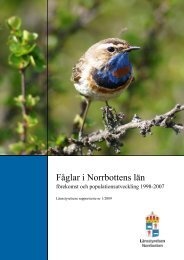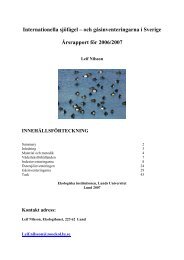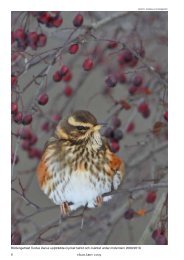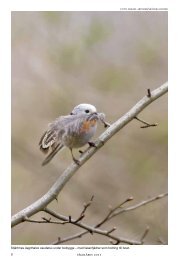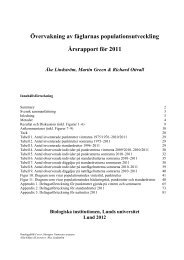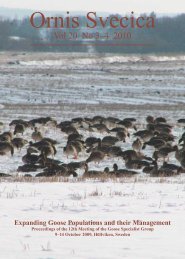Distribution and numbers of wintering sea ducks ... - Lunds universitet
Distribution and numbers of wintering sea ducks ... - Lunds universitet
Distribution and numbers of wintering sea ducks ... - Lunds universitet
Create successful ePaper yourself
Turn your PDF publications into a flip-book with our unique Google optimized e-Paper software.
Table 8. Estimated totals <strong>of</strong> Red-breasted Mergansers Mergus serrator in different areas along the Swedish Baltic<br />
coast in the winters 2007–2011. <strong>Distribution</strong> map for 2009 in figure 17. A dash indicates absence <strong>of</strong> count.<br />
Skattat antal småskrakar Mergus serrator inom olika områden efter den svenska Östersjökusten 2007–2011.<br />
Utbredningskarta för 2009 i Figur 17. Ett streck anger avsaknad av räkning.<br />
Area 2007 2009 2010 2011<br />
falsterbo 2600 2000 4510 2610<br />
Skåne south coast 200 300 – 760<br />
Skåne southeast – – – 0<br />
Hanöbukten 200 700 – 110<br />
Blekinge archipelago 0 670 – 0<br />
Kalmarsund 900 1200 60 638<br />
Öl<strong>and</strong> east coast 300 500 – 1575<br />
Öl<strong>and</strong> North banks 0 0 0 102<br />
Midsjöbankarna – 0 60 0<br />
Hoburg Bank – 0 0 238<br />
Gotl<strong>and</strong> east coast – 1700 – 163<br />
Gotl<strong>and</strong> north – – – 0<br />
Gotl<strong>and</strong> west – 825 – –<br />
Kalmar archipelago – 0 – ICE<br />
Östergötl<strong>and</strong> archipelago – 0 – ICE<br />
Södermanl<strong>and</strong> archipelago – 0 – ICE<br />
Stockholm archipelago – 0 – ICE<br />
Uppl<strong>and</strong> coast – 0 – ICE<br />
Gävlebukten – 0 – ICE<br />
Total 7840<br />
Discussion<br />
from the data presented here <strong>and</strong> in comparison<br />
with the estimates from the total surveys <strong>of</strong> <strong>wintering</strong><br />
<strong>sea</strong>birds in the Baltic (Durinck et al. 1994,<br />
Skov et al. 2011; see also Delany & Scott 2006 for<br />
the entire NW Europe) it is clear that the Swedish<br />
<strong>of</strong>fshore areas in the Baltic are <strong>of</strong> very large<br />
international importance for <strong>wintering</strong> <strong>sea</strong><strong>ducks</strong>,<br />
especially for the long-tailed Duck but also for the<br />
Red-breasted Merganser (Nilsson 2008) whereas<br />
the two scoter species are more sparse.<br />
When comparing the estimates for Swedish waters<br />
presented here with the population estimates<br />
for NW Europe presented by Delany & Scott<br />
(2006) <strong>and</strong> with the two All Baltic surveys (Durinck<br />
et al. 1994, Skov et al. 2011) it is important<br />
to bear in mind the differences in methods used<br />
during the two all Baltic surveys with the different<br />
uncertainties <strong>and</strong> biases attached to the two<br />
methods (see above). These factors will also have<br />
a great importance when evaluating the population<br />
changes indicated in the report from the SOWBAS<br />
study (Skov et al. 2011).<br />
The results <strong>of</strong> the two all-Baltic surveys indicate<br />
a very marked decrease in the population <strong>of</strong> longtailed<br />
Duck between the two surveys, from 4.3 to<br />
1.5 million (Skov et al 2011). The Swedish winter-<br />
54<br />
ing population was 32% <strong>and</strong> 29% <strong>of</strong> the published<br />
estimates for the entire Baltic in the two surveys,<br />
showing that the decline was similar in Swedish<br />
waters as elsewhere. The decrease in the population<br />
within Swedish waters was mainly concentrated<br />
to Hoburgbank <strong>and</strong> the <strong>of</strong>fshore waters <strong>of</strong><br />
east Gotl<strong>and</strong>, whereas there was no such decrease<br />
for the Midsjö banks <strong>and</strong> with stable <strong>wintering</strong><br />
<strong>numbers</strong> or only smaller decreases (within the calculation<br />
error) established for the <strong>wintering</strong> areas<br />
around Öl<strong>and</strong> <strong>and</strong> along the mainl<strong>and</strong> coast.<br />
In spring, the long-tailed Ducks migrate to the<br />
breeding areas in northern Russia, a major part <strong>of</strong><br />
the population passing the Gulf <strong>of</strong> finl<strong>and</strong>. During<br />
this migration the <strong>numbers</strong> have been counted from<br />
sites in finl<strong>and</strong> <strong>and</strong> Estonia (Bergman 1974, Hario<br />
et al. 2009). Counts at Söderskär on the finnish<br />
coast showed an increase from about 1970 to the<br />
early 1990s, followed by a marked decrease (Hario<br />
et al. 2009, see also Kauppinen & leivo 2008).<br />
The highest counts <strong>of</strong> spring migrants coincided<br />
with the first all Baltic survey (1992/1993), which<br />
yielded much higher estimates than the 2007–2009<br />
survey. Unfortunately there are no available data<br />
to show whether there has been a similar increase<br />
in the <strong>numbers</strong> <strong>of</strong> <strong>wintering</strong> long-tailed Ducks in<br />
the Baltic as indicated from the finnish migration


